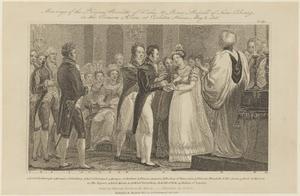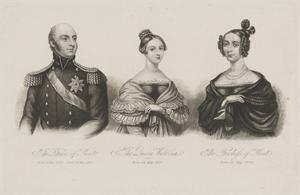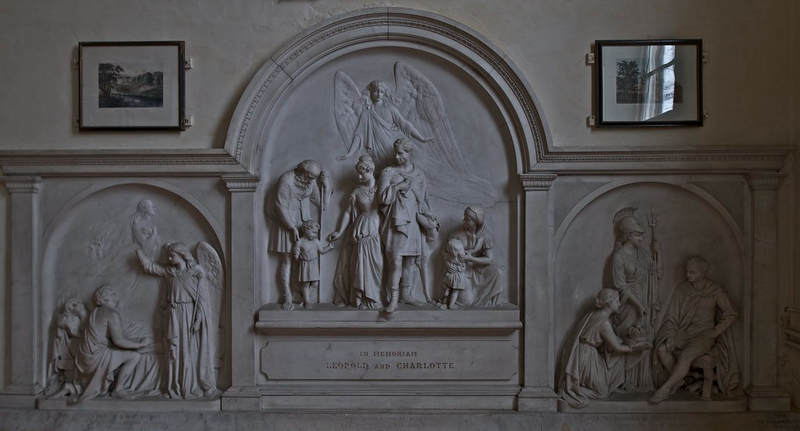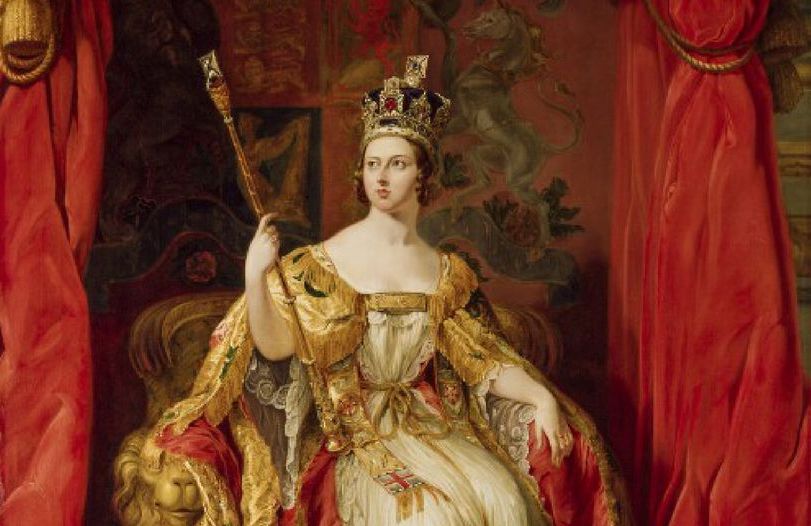The Parish Church of Royalty
The charming Tudor church of St George's, Esher in Surrey has links with Queen Victoria
Claremont House
The first house at Claremont was built in 1708 by architect and playwright Sir John Vanbrugh, for his own use. Vanbrugh was also the architect of Blenheim Palace and Castle Howard. The House wasn't to last for long as in just over fifty years time, the Lord Robert Clive who bought the estate in 1768, deemed that it was no longer fashionable and decided to have it demolished and a new house would be built. Lord Clive employed Lancelot "Capability" Brown to design the new house. Sadly, Lord Clive would never get to live in the great mansion he spent over £100,000 on as as he died in 1774—the very year that the house was finished.
Following his death the mansion passed through a succession of new owners rapidly, before Parliament stepped in.

'Marriage of the Princess Charlotte of Wales to Prince Leopold of Saxe-Cobourg' by Robert Hicks, published April 1818. NPG D16053
A Royal Palace in the making
In 1816 the Mansion and Estate were purchased by the government through an Act of Parliament as a wedding present from the British Nation for the daughter of King George IV, Princess Charlotte, and her husband Prince Leopold of Saxe-Coburg.
Tragedy would befall the young Royal Couple however, and great sorrow would come to the Nation. Princess Charlotte suffered two miscarriages, and on 6 November 1817, the second in line to the Throne, who would have become Queen, died shortly after giving birth to a stillborn son.
This created a succession crisis. Newspapers and Parliament intervened encouraging the remaining three sons of King George III to marry - Parliament even offered a financial incentive. One of Princess Charlotte's uncles, Prince Edward, Duke of Kent and Strathearn proposed to the sister of Prince Leopold of Saxe-Coburg; the Princess Victoria of Saxe-Coburg-Saalfeld.
The couple were married on 29 May 1818 in Bavaria. Shortly after their marriage, the Kents moved to Germany where they could afford a more comfortable lifestyle. Shortly after their marriage, Victoria fell pregnant, and with both the Duke and Duchess keen to see their child born in England, they speedily set off for England. They arrived at the port of Dover on 23 April 1819, where they moved into Kensington Palace. On 24 May 1819, Princess Alexandrina Victoria of Kent, later Queen Victoria was born.

Prince Edward, Duke of Kent and Strathearn; Queen Victoria; Princess Victoria, Duchess of Kent and Strathearn late 1830s, NPG D33560
Queen Victoria
In 1820, when the Princess was not even reached her first birthday, her father died of pneumonia in January 1820, six days before his father, King George III. This left both Victoria and her mother in dilapidated accommodation at Kensington Palace. As a result, the young Princess would often escape central London to visit and stay with her uncle, Prince Leopold at Claremont.
Following the death of his first wife, Princess Charlotte, Leopold retained ownership of Claremont until his death in 1865. However, he left the house in 1831 when he became the first King of the Belgians.
Victoria would later acquire the House and would allow the exiled French king and queen, Louis-Philippe and Marie-Amelie to live at Claremont following the revolutions of 1848. The King died at Claremont in 1850.
St George's Church, Esher
Inside St George's can be found a chamber pew with Corinthian columns which was designed by Vanbrugh in 1725 for Thomas, Duke of Newcastle, Prime Minister and owner of Claremont. He shared it with his brother, Henry Pelham of Esher Place. Thereafter, it was used by the owners of both estates. Occupants included the Princess Charlotte and Prince Leopold and future Queen Victoria and Prince Albert, and their son Prince Leopold and Princess Alice, Countess of Athlone.
In 1870 Queen Victoria wished to create a memorial to her uncle and his first wife, Princess Charlotte. The monument to the Princess Charlotte, given to the church by the Duchess of Albany in 1910, was commissioned by Queen Victoria from Francis John Williamson, her favourite sculptor, who lived in Esher. Charlotte lies on her deathbed; her husband, Prince Leopold, watches. The central panel depicts the couple giving alms to the Esher poor (cover) and on the right Leopold accepts the crown ofthe Belgians while Britannia looks on. You can see this monument inside the church still today.


